Martienssen W., Warlimont H. (Eds.). Handbook of Condensed Matter and Materials Data
Подождите немного. Документ загружается.

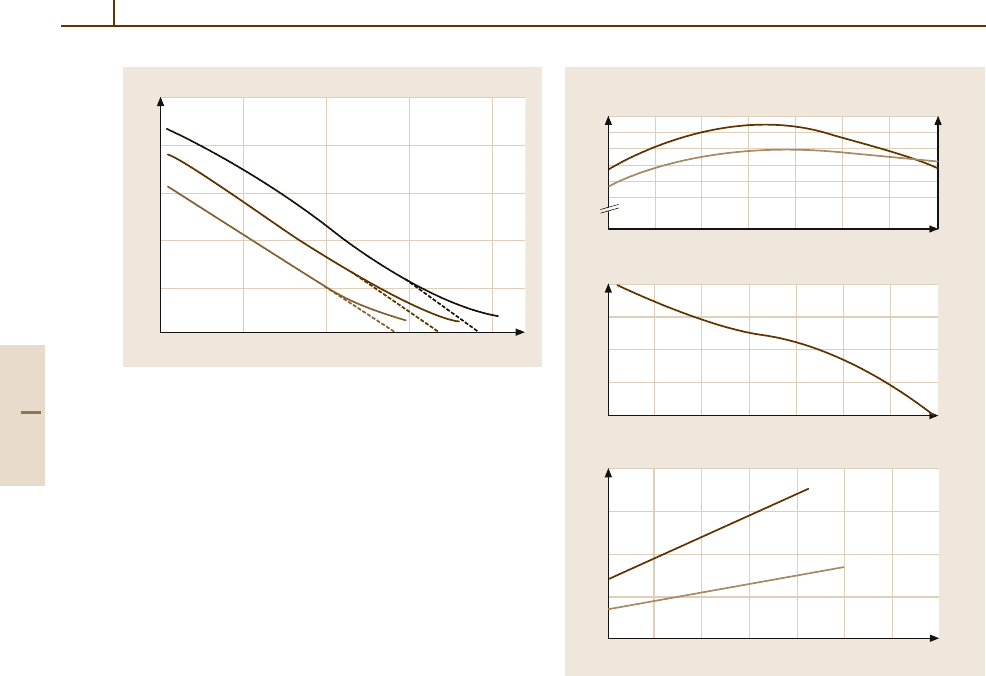
772 Part 4 Functional Materials
0.5
0.4
0.3
0.2
0.1
0
0 20406080
T(°C)
B (T)
75
65
55
T
c
Fig. 4.3-15 Induction vs. temperature of Fe
−
Ni alloyswith
approximately 30% Ni as a function of Curie tempera-
ture [3.17]
they have the highest resistivity of all Ni
−
Fe al-
loys and a saturation polarization between 1.3and
1.5T.
The Curie temperature of the alloys with about
30 wt% Ni is near room temperature. Accordingly, the
magnetization is strongly temperature-dependent in this
vicinity (see Fig. 4.3-15). By slight variation of the Ni
content (a composition increase of 0.1 wt% Ni gives rise
to an increase of T
c
by 10 K) T
c
can be varied between
30
◦
C and 120
◦
C. These alloys are used mainly for tem-
perature compensation in permanent magnet systems,
measuring systems, and temperature sensitive switches
[3.16].
4.3.2.5 Iron–Cobalt Alloys
Of all known magnetic materials, Fe
−
Co alloys with
about 35 wt% Co havethe highest saturation polarization
I
s
= 2.4 T at room temperature and the highest Curie
temperature of nearly 950
◦
C. The intrinsic magnetic
properties I
s
, T
c
, K
1
,andλ
hkl
as a function of Co content
are shown in Fig. 4.3-16.
Since K
1
and λ
s
have minima at different Co con-
tents, different compositions for different applications
have been developed. A Fe–49 wt% Co–2 wt% V com-
position is commonly used. The V addition reduces the
brittleness by retarding the structural ordering transfor-
mation, improves the rolling behavior, and increases
the electrical resistivity. The workability of Co
−
Fe al-
loys is difficult altogether. Two further alloy variants
containing 35 wt% Co and 27 wt% Co, respectively, are
of technical interest. They are applied where highest
flux density is required, e.g., in magnet yokes, pole
2.5
2
40
20
0
–20
–40
1000
500
150
100
50
0
–50
0 204060
0204060
0204060
Saturation
polarization J
s
(Τ)
Curie temperature
T
c
(°C)
Co-content (wt %)
Co-content (wt %)
Co-content (wt %)
Magnetocrystalline anisotropy K
1
(kJ m
–3
)
J
s
T
c
K
1
100
λ
111
λ
λ
(10
–6
)
Magnetostriction
Fig. 4.3-16 The dependence of intrinsic magnetic param-
eters I
s
, T
c
, K
1
and λ of Co
−
Fe alloys on the Co
content [3.12]
shoes, and magnetic lenses. The high T
c
makes Fe
−
Co
based alloys applicable as high temperature magnet
material.
4.3.2.6 Amorphous Metallic Alloys
By rapid quenching of a suitable alloy from the melt at
a cooling rate of about 10
−5
–10
−6
K/s, an amorphous
metallic state will be produced where crystallization is
suppressed. Commonly, casting through a slit nozzle
onto a rotating copper wheel is used to form a ribbon-
shaped product. The thickness of the ribbons is typically
between 20 and 40 µm.
From the magnetic point of view amorphous al-
loys have several advantages compared to crystalline
alloys: they have no magnetocrystalline anisotropy, they
combine high magnetic softness with high mechanical
hardness and yield strength, their low ribbon thickness
and their high electrical resistivity (100–150 µΩ cm)
Part 4 3.2
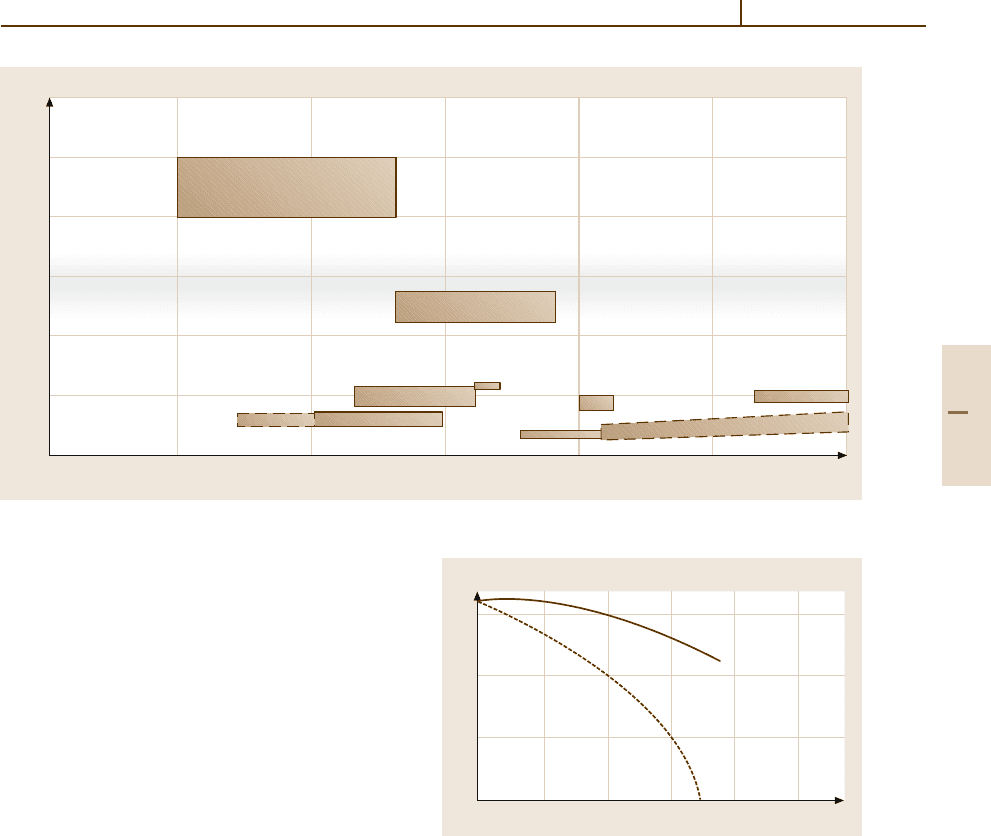
Magnetic Materials 3.2 Soft Magnetic Alloys 773
1200
1000
800
600
400
200
0
0.1 0.3 1 3 10 30 100
Coercivity H
c
(A/m
–1
)
Vickers hardness (HV)
amorphouscrystalline
Fe–, NiFe–, Co-base
10% Si, 5% Al, 85% Fe (Sendust)
77% NiFe with
hardening additions
16% Al Fe
3% SiFe
Fe
50% CoFe
77% NiFe+Mo, Cu
Fig. 4.3-17 Vickers hardness and coercivity of crystalline and amorphous alloys [3.12]
provide excellent soft magnetic material properties
for high frequency applications, in particular low
losses. A plot of Vickers hardness (HV) vs. coer-
civity (H
c
) for crystalline and amorphous alloys is
shown in Fig. 4.3-17 and indicates that a particularly
favorable combination for soft magnetic amorphous al-
loys applies: being magnetically soft and mechanically
hard.
The soft magnetic properties of amorphous alloys
depend essentially on alloy composition, focusing on
a low saturation magnetostriction λ
s
, high glass forming
ability required for ribbon preparation at technically ac-
cessible cooling conditions, and annealing treatments
which provide structural stability and field-induced
anisotropy K
u
.
The soft magnetic amorphous alloys are based on the
ferromagnetic elements Fe, Co, and Ni with additions of
metalloid elements, the so-called glass forming elements
Si, B, C, and P. The most stable alloys contain about
80 at.% transition metal (TM) and 20 at.% metalloid (M)
components.
Depending on their base metal they exhibit
characteristic differences of technical significance.
Accordingly they are classified into three groups: Fe-
based alloys, Co-based alloys, and Ni-based alloys.
The characteristic variation of their intrinsic magnetic
properties saturation polarization I
s
, saturation magne-
tostriction λ
s
, and the maximum field induced magnetic
1.5
1.0
0.5
0
0 20 40 60 80 100
Fe
Saturation polarization J
s
(Τ)
x (at. %) Co or Ni
a)
b)
Fig. 4.3-18a,b Saturation polarization J
s
of Fe-based
amorphous alloys depending on Co and Ni con-
tent:
(a) Fe
80−x
Co
x
B
20
(O’Handley, 1977) [3.18].
(b) Fe
80−x
Ni
x
B
20
(Hilzinger, 1980) [3.12,19]
anisotropy energy K
u
, as functions of alloy concentra-
tion is shown in Figures 4.3-18 to 4.3-20.
Iron–Based Amorphous Alloys
Of all amorphous magnetic alloys, the iron-richalloys on
the basis Fe
∼80
(Si, B)
∼20
have the highest saturation po-
larization of 1.5–1.8 T. Because of their relatively high
saturation magnetostriction (λ
s
) of around 30× 10
−6
,
their use as soft magnetic material is limited. The
application is focused on transformers at low and
Part 4 3.2
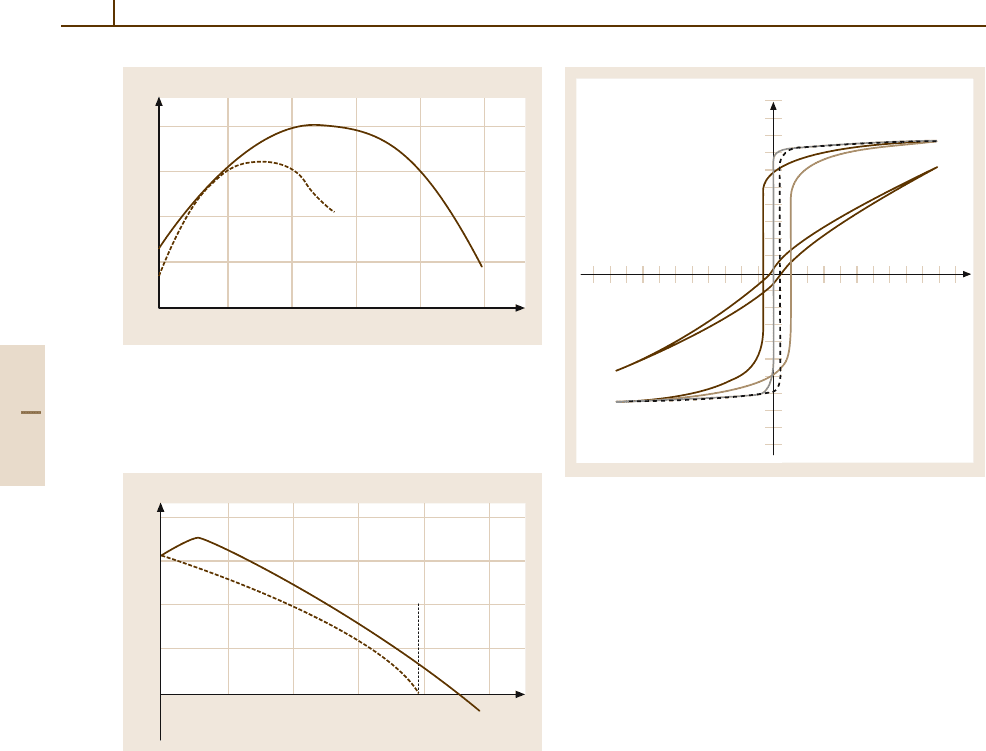
774 Part 4 Functional Materials
0.8
0.6
0.4
0.2
0
0 0.2 0.4 0.6 0.8 1.0
Magnetic field induced anisotropy K
u
(kJ m
–3
)
x Co or Ni
a)
b)
Fig. 4.3-19a,b Fieldinduced anisotropy K
u
of FeCo-based
and FeNi-basedamorphous alloys:
(a) (Fe
1−x
Co
x
)
77
Si
10
B
13
(Miyazaki et al., 1972) [3.20]. (b) (Fe
1−x
Ni
x
)
80
B
20
(Fuji-
mori et al., 1976) [3.12, 21]
40
30
20
10
0
–10
0.2 0.4 0.6 0.8 1.0
λ
(10
–6
)
Magnetostriction
s
Ni/(Ni + Fe)
Co/(Co + Fe)
a)
b)
Fig. 4.3-20a,b Magnetostriction λ
s
of FeCo-based and
FeNi-based amorphous alloys depending on Co and Ni
Content:
(a) (FeCo)
80
B
20
[3.18]. (b) (FeNi)
80
B
20
[3.12,
18]
medium frequencies in electric power distribution
systems.
Compared to grain-oriented silicon steels the
iron-rich amorphous alloys show appreciably lower co-
ercivity and consequently lower total losses.
The physical and magnetic properties of a character-
istic commercial Fe-rich Metglas amorphous alloy are
shown in Fig. 4.3-21 and Table 4.3-21 [3.22].
1.0 0.5 0.5 1.0
1.0
2.0
1.0
2.0
B(T)
H(Oe)
Transverse field anneal
No-field anneal
Longitudinal field anneal
Fig. 4.3-21 Typical dc hysteresis loop of Fe-rich MET-
GLAS alloy SA 1 [3.22]
Cobalt–Based Amorphous Alloys
In the (Fe
x
Co
1−x
)
∼80
B
∼20
system the saturation mag-
netostriction λ
s
passes through zero. Along with a proper
selection of alloy composition this behavior gives rise
to a particularly low coercivity, the highest permeability
of all amorphous magnetic alloys, low stress sensitivity,
and extremely low total losses.
The saturation polarization ranging from 0.55 to
1.0 T is lower than in Fe-rich amorphous alloys but
comparable to the ∼ 80 wt% Ni crystalline permalloy
materials. By applying magnetic field annealing, well-
controlled Z-type and F-type loops can be realized.
Nickel–Based Amorphous Alloys
A typical composition of this amorphous alloy group is
Fe
40
Ni
40
(Si, B)
20
, with a saturation polarization I
s
of
0.8 T and a saturation magnetostriction λ
s
of 10× 10
−6
.
The latter is causing magnetoelastic anisotropy which
can be applied to design magnetoelastic sensors where
a change in the state of applied stress causes a change in
permeability and loop shape, respectively. Upon anneal-
ing, Fe
−
Ni-based alloys will have an R-(round) type
Part 4 3.2
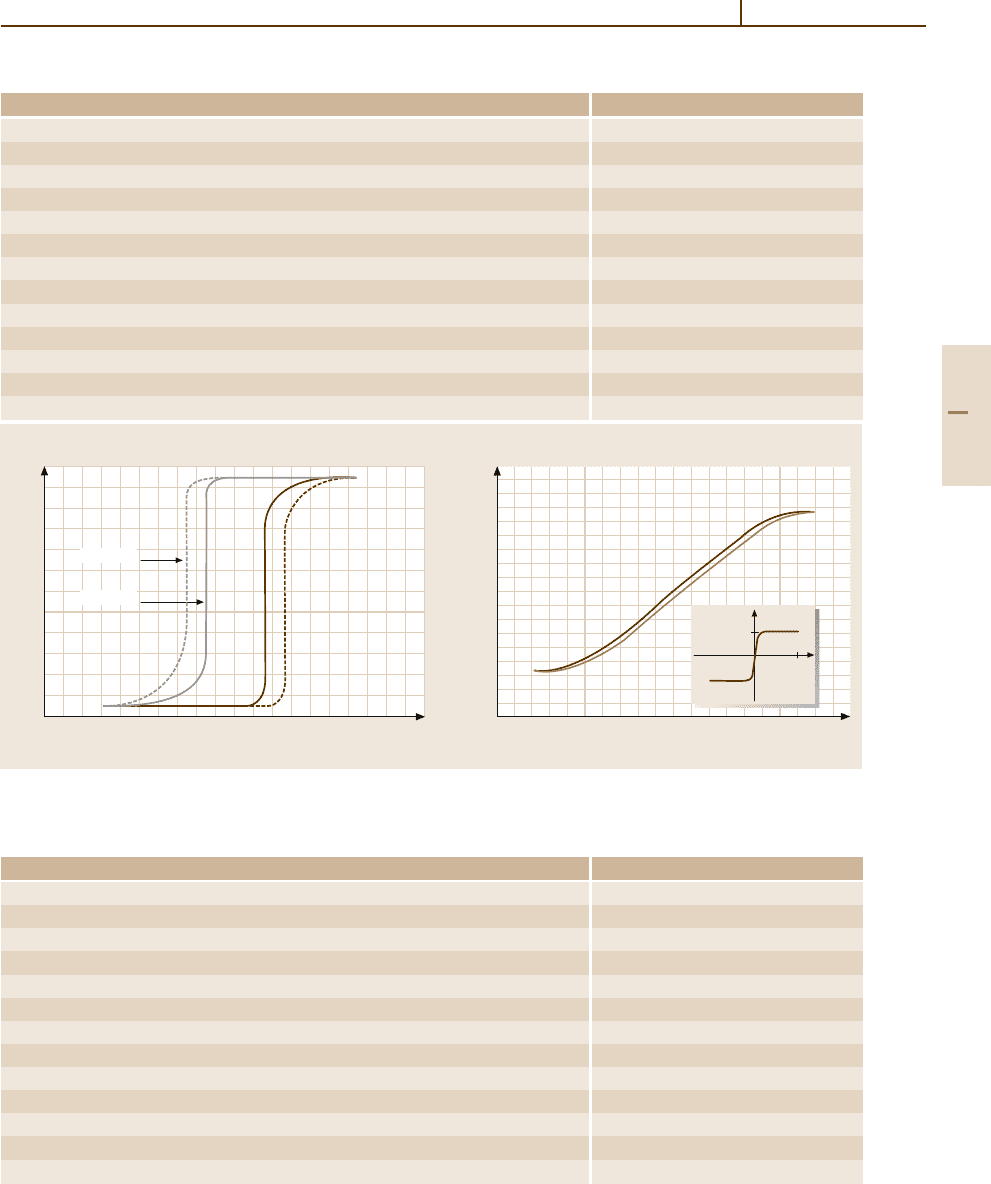
Magnetic Materials 3.2 Soft Magnetic Alloys 775
Table 4.3-21 Physical and magnetic properties of Fe-rich METGLAS alloy SA 1 [3.22]
Property Value
Ribbon Thickness (µm) 25
Density (g/cm
3
) 7.19
Thermal Expansion (ppm/
◦
C) 7.6
Crystallization Temperature (
◦
C) 550
Curie Temperature (
◦
C) 415
Countinuous Service Temperature (
◦
C) 155
Tensile Strength (MN/m
2
) 1–1.7k
Elastic Modulus (GN/m
2
) 100–110
Vicker‘s Hardness (50 g load) 860
Saturation Flux Density (Tesla) 1.56
Permeability (depending on gap size) Variable
Saturation Magnetostriction (ppm) 27
Electrical Resistivity (µΩ cm) 137
0.6
0.5
0.4
0.3
0.2
0.1
0
–0.1
–0.2
–0.3
–0.4
–0.5
–0.6
–160 –128 –96 –64 –32 0 32 64 96 128 160
0.8
0.6
0.4
0.2
0
–0.2
–0.4
–0.6
–0.8
–8 –6 –4 –2 0 2 4 6 8
Flux Density (T)
a)
Magnetizing Force (Am
–1
)
200 kHz
100 kHz
b)
Flux Density (T)
Magnetizing Force (Am
–1
)
B
H
0.55 T
80 A/m
Fig. 4.3-22a,b Typical dc hysteresis loop of Co-based METGLAS alloy: (a) alloy 2714 AS (Z-loop) and (b) alloy 2714
AF (F-loop) [3.22]
Table 4.3-22 Physical and magnetic properties of the cobalt-based amorphous alloy METGLAS alloy 2714 AF [3.22]
Property Value
Ribbon Thickness (µm) 18
Density (g/cm
3
) 7.59
Thermal Expansion (ppm/
◦
C) 12.7
Crystallization Temperature (
◦
C) 560
Curie Temperature (
◦
C) 225
Countinuous Service Temperature (
◦
C) 90
Tensile Strength (MN/m
2
) 1–1.7k
Elastic Modulus (GN/m
2
) 100–110
Vicker‘s Hardness (50 g load) 960
Saturation Flux Density (Tesla) 0.55
Permeability (µ@1 kHz, 2.0mA/cm) 90 000±20%
Saturation Magnetostriction (ppm) 1
Electrical Resistivity (µΩ cm) 142
Part 4 3.2

776 Part 4 Functional Materials
Table 4.3-23 Survey of soft magnetic amorphous and nanocrystalline alloys. Some amorphous alloy of METGLAS (Allied
Signal Inc., Morristown/NJ) and VITROVAC (Vacuumschmelze GmbH, Hanau, Germany) have been selected from commercially
available alloys [3.12]
Composition Typical properties
Saturation Curie Saturation Coercivity Permeability
a
Density Specific electrical
polarization temperature magnetostriction (dc) at H = 4mAm
−1
in resistivity
b
in (T) in (
◦
C) in 10
−6
in (A m
−1
) ×10
3
(g cm
−3
) in ( mm
2
m
−1
)
Amorphorus
Fe-based:
Fe
78
Si
9
B
13
1.55 415 27 3 8 7.18 1.37
Fe
67
Co
18
Si
1
B
14
1.80 ∼550
c
35 5 1.5 7.56 1.23
FeNi-based:
Fe
39
Ni
39
Mo
2
Si
12
B
8
0.8 260 +8 2 20 7.4 1.35
Co-based:
Fe
67
Fe
4
Mo
1
Si
17
B
11
0.55 210 < 0.2 0.3 100 7.7 1.35
Fe
74
Fe
2
Mn
4
Si
11
B
9
1.0 480
c
< 0.2 1.0 2 7.85 1.15
Nanocristalline
Fe
73.5
Cu
1
Nb
3
Si
13.5
B
9
1.25 600 +2 1 100 7.35 1.35
a
Materials with round (R) or flat loops (F), f = 50 Hz
b
1 Ω mm
2
/m =10
−4
Ω cm
c
Extrapolated values (T
c
> T
x
, T
x
: crystallization temperature)
hysteresis loop associated with high initial permeability,
or an F-type loop with low losses.
Table 4.3-23 gives a survey of the magnetic and
physical properties of several soft magnetic amorphous
alloys
4.3.2.7 Nanocrystalline Soft Magnetic Alloys
Nanocrystalline soft magnetic alloys are a rather re-
cent class of soft magnetic materials with excellent
magnetic properties such as low losses, high perme-
ability, high saturation polarization up to 1.3T, and
near-zero magnetostriction. The decisive structural fea-
ture of this alloy type is its ultra-fine microstructure of
bcc α-Fe
−
Si nanocrystals, with grain sizes of 10–15 nm
which are embedded in an amorphous residual phase.
Originally, this group of materials was discovered in
the alloy system Fe
−
Si
−
B
−
Cu
−
Nb with the compo-
sition Fe
73.5
Si
15.5
B
7
Cu
1
Nb
3
. This material is prepared
by rapid quenching like an amorphous Fe
−
Si
−
B alloy
with a subsequent annealing treatment and compara-
tively high temperature in the range of 500 to 600
◦
C
which leads to partial crystallization.
The evolution of the nanocrystalline state during
annealing occurs by partial crystallization into ran-
domly oriented, ultrafine bcc α-Fe
−
Si grains that are
10–15 nm in diameter. The residual amorphous matrix
phase forms a boundary layer that is 1–2 nm thick. This
particular nano-scaled microstructure is the basis for
ferromagnetically-coupled exchange interaction of and
through these phases, developing excellent soft mag-
netic properties: µ
a
≈ 10
5
, H
c
< 1Am
−1
. Annealing
above 600
◦
C gives rise to the precipitation of the borides
Fe
2
B and/or Fe
3
B with grain sizes of 50–100 nm. At
higher annealing temperatures, grain coarsening arises.
Both of these microstructural changes are leading to
a deterioration of the soft magnetic properties.
The influence of the annealing temperature on grain
size, H
c
, and µ
i
of a nanocrystalline type alloy is shown
in Fig. 4.3-23 [3.23].
The small additions of Cu and Nb favor the forma-
tion of the nanocrystalline structure. Copper is thought
to increase the rate of nucleation of α-Fe
−
Si grains by
a preceding cluster formation, and Nb is supposed to
lower the growth rate because of its partitioning effect
and decrease of diffusivity in the amorphous phase. Fig-
ure 4.3-24 illustrates theformation of the nanocrystalline
structure schematically.
It is useful to note the influence of the atomic
diameter of alloying additions on the grain size of the
α-Fe
−
Si phase starting from the classical alloy compo-
sition Fe
73.5
Si
15.5
B
7
Cu
1
Nb
3
. This effect is shown for
Part 4 3.2
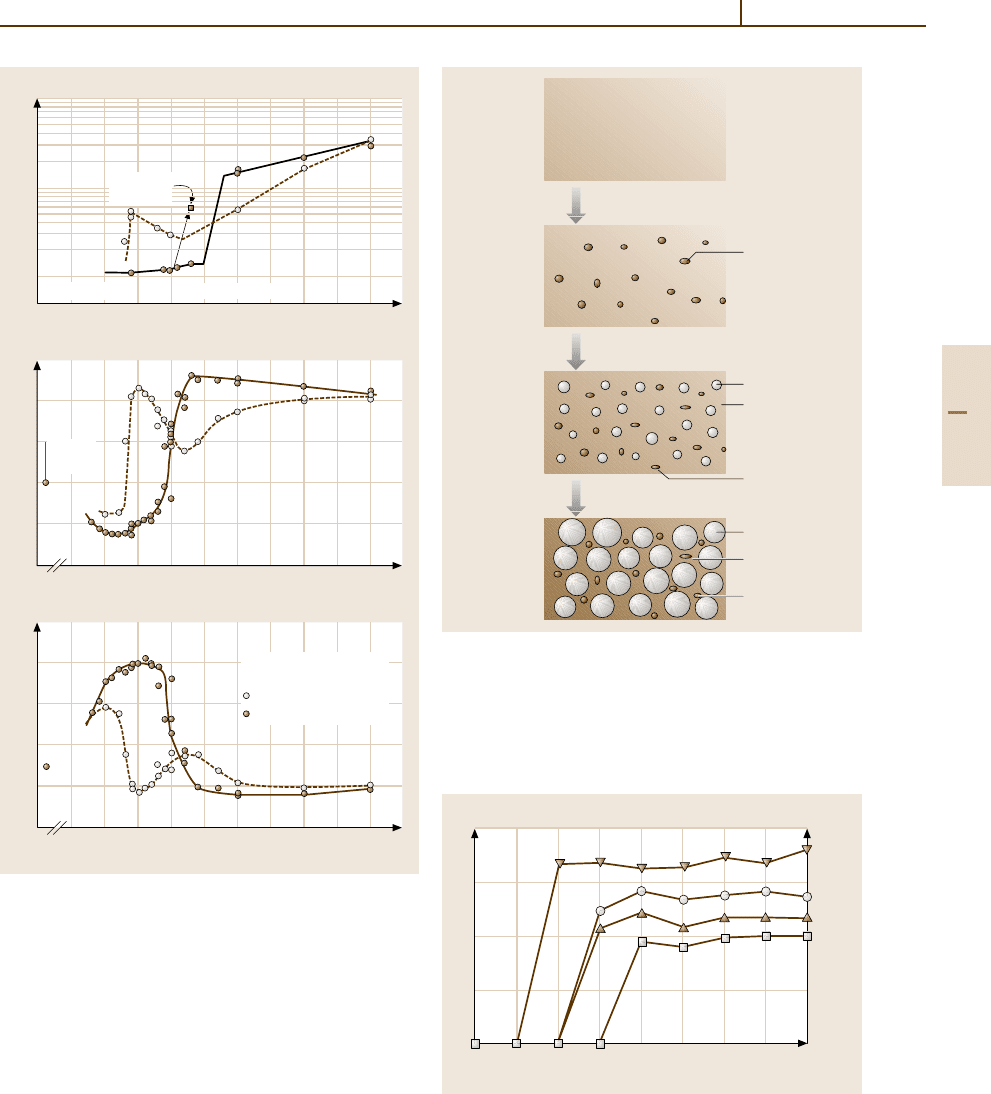
Magnetic Materials 3.2 Soft Magnetic Alloys 777
10
3
10
2
10
1
500 600 700 800 900
Annealing temperature T
a
(°C)
10
3
10
2
10
1
10
0
500 600 700 800 900
Annealing temperature T
a
(°C)
10
5
10
4
10
3
10
2
500 600 700 800 900
Annealing temperature T
a
(°C)
Grain size (nm)
Amorphous
Fe
2
B
-Fe-Si (v~70%)
α
(v~10%)
Coercivity (Am
–1
)
As Pre-
pared
Permeability
Fe
74.5– x
Cu
x
Nb
3
Si
13.5
B
9
annealed 1h at
x
Cu
= 0 at.%
x
Cu
= 1 at.%
T
a
Fig. 4.3-23 Average grain size, coercivity and initial per-
meability of a nanocrystalline soft magnetic alloy as
a function of the annealing temperature [3.23]
partial substitution of Nb by V, Mo, W, and Ta (2 at.%
each) in Fig.4.3-25. The larger the atomic diameter, the
smaller the resulting grain size. The elements Nb and Ta
have the same atomic diameter. Furthermore, the smaller
the atomic diameter of the alloying element, the sooner
the crystallization of the α-Fe-Si phase begins.
One of the decisive requirements for excellent soft
magnetic properties is the absence of magnetostriction.
Amorphous Fe
−
Si
−
B
−
Cu
−
Nb alloys have a saturation
As quenched
Amorphous
Fe-Cu-Nb-Si-B
Compositional fluctuations
Cu-rich region
Early
annealing
stage
(amorphous)
Nucleation of bcc Fe-Si
bcc Fe-Si
Amorphous Nb
and B enriched
matrix
(higher T
x
)
Cu cluster (fcc)
bcc Fe-Si
Amorphous
Fe-Nb-B matrix
Cu cluster (fcc)
Initial stage
of crystalli-
zation
Optimum
nanocrystal-
line state
Grain growth
Fig. 4.3-24 Schematic illustration of the formation of the
nanocrystalline structure in Fe
−
Cu
−
Nb
−
Si
−
B alloys,
based on atom probe analysis results and transmission
electron microscopy observations by Hono et al. [3.23,
24]
20
15
10
5
0
400 425 450 475 500 525 550 575 600
Annealing temperature T
A
(°C) (t =1h/H
2
)
0.264
0.272
0.274
0.286
-FeSi grain size (nm)
α
V
Mo
W
Ta
Atomic diameter (nm)
Fig. 4.3-25 Influence of partial substitution of Nb by
the refractory elements R = V , Mo, W and Ta on
the α-FeSi grain size during annealing of the alloy
Fe
73.5
Si
15.5
B
7
Cu
1
Nb
3
R
2
[3.25]
Part 4 3.2
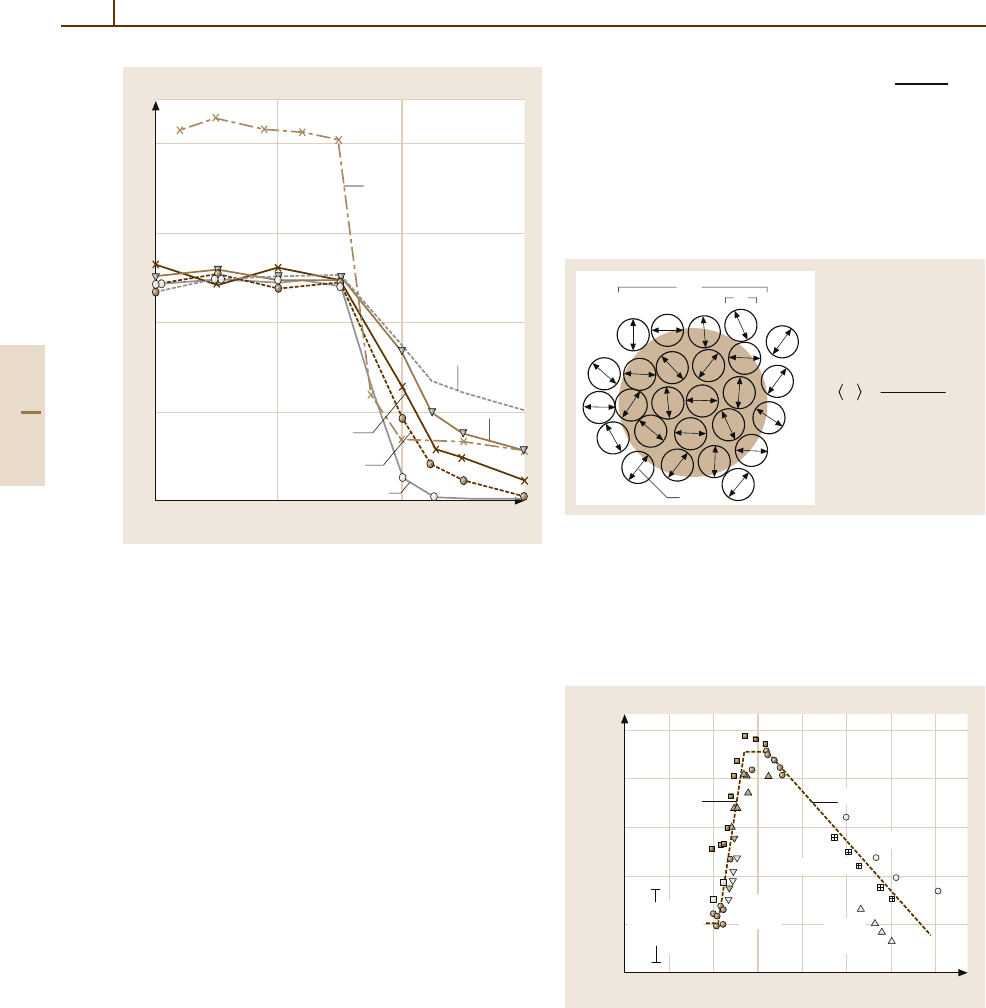
778 Part 4 Functional Materials
40
30
20
10
0
300 400 500 600
Annealing temperature T
A
(°C) (t=2h/H
2
)
45
Saturation magnetostriction
λ
(10
–6
)
s
Si:
7 at.%, without Cu, Nb
Si (at.%)
7.0
9.5
11.5
13.5
16.5
Fig. 4.3-26 Influence of the Si-content on the saturation
magnetostriction λ
s
during annealing of the nanocrystalline
alloys Fe
(75−73.5)
Si
(7−16.5)
B
(14−6)
Cu
1
Nb
3
[3.26]
magnetostriction λ
s
≈ 24 × 10
−6
, with a magnetoelastic
anisotropy energy K
σ
≈ 50 J m
−3
. With partial crystal-
lization of the α-Fe
−
Si phase during annealing, λ
s
varies
significantly. At higher Si contents it decreases strongly
and passes through zero at about 16 at.% Si, as shown in
Fig. 4.3-26.
This behavior is caused by the compensation of the
negative saturation magnetostriction λ
s
of the α-Fe
−
Si
phase λ
s
≈−8×10
−6
and the positve values of λ
s
of the
residual amorphous phase of λ
s
≈+24× 10
−6
.
The superposition of the local magnetostrictive
strains to an effective zero requires a large crystalline
volume fraction of about 70 vol.% to compensate the
high positive value of the amorphous residual phase
of about 30 vol.%. By anealing at about 550
◦
Cthis
relation can be realized. The second requirement for su-
perior soft magnetic properties is a small or vanishing
magnetocrystalline anisotropy energy K
1
.
By developing a particular variant of the ran-
dom anisotropy model, it was shown [3.27] that for
grain diameters D smaller than the magnetic exchange
length L
0
, the averaged anisotropy energy density K
is given by
K
≈ v
2
cr
K
1
(DL
−1
0
)
6
= v
2
cr
D
6
K
4
1
A
−3
,
where v
cr
= crystallized volume, K
1
= intrinsic crys-
tal anisotropy energy of α-Fe
−
Si, L
0
=
!
AK
−1
1
,and
A =exchange stiffness constant. A schematic represen-
tation of this model is given in Fig. 4.3-27. The basic
effect of decreasing the grain size consists of local av-
eraging of the magnetocrystalline anisotropy energy K
1
for D =10–15 nm at L
0
= 30–50 nm (about equal to
L
ex
N = v
cr
(L
ex
/ D)
3
K
1
K
=
√N
v
cr
K
1
×
D
Fig. 4.3-27 Schematic representation of the random
anisotropy model for grains embedded in an ideally soft
ferromagnetic matrix. The double arrows indicate the ran-
domly fluctuating anisotropy axis; the dark area represents
the ferromagnetic correlation volume determined by the
exchange length L
ex
= (A/K )
1/2
[3.23]
10000
1000
100
10
1
0.1
1 nm 1 µm
Grain size D
1 mm
H
c
(Am
–1
)
Fe-base
Amorphous
Co-base
Nano-
cryst.
Perm-
alloy
D
6
1/D
50 NiFe
FeSi 6.5
Fig. 4.3-28 Coercivity, H
c
, vs. grain size, D, for vari-
ous soft magnetic metallic alloys [3.27]: Fe
−
Nb
−
Si
−
B
(solid up triangles) [3.28], Fe
−
Cu
−
Nb
−
Si
−
B(solid
circles) [3.29, 30], Fe
−
Cu
−
V
−
Si
−
B(solid and open
down triangles) [3.31], Fe
−
Zr
−
B(open squares) [3.32],
Fe
−
Co
−
Zr (open diamonds) [3.33], NiFe-alloys (+center
squares and open up triangles) [3.34], and Fe
−
Si(6.5wt%)
(open circles) [3.35]
Part 4 3.2
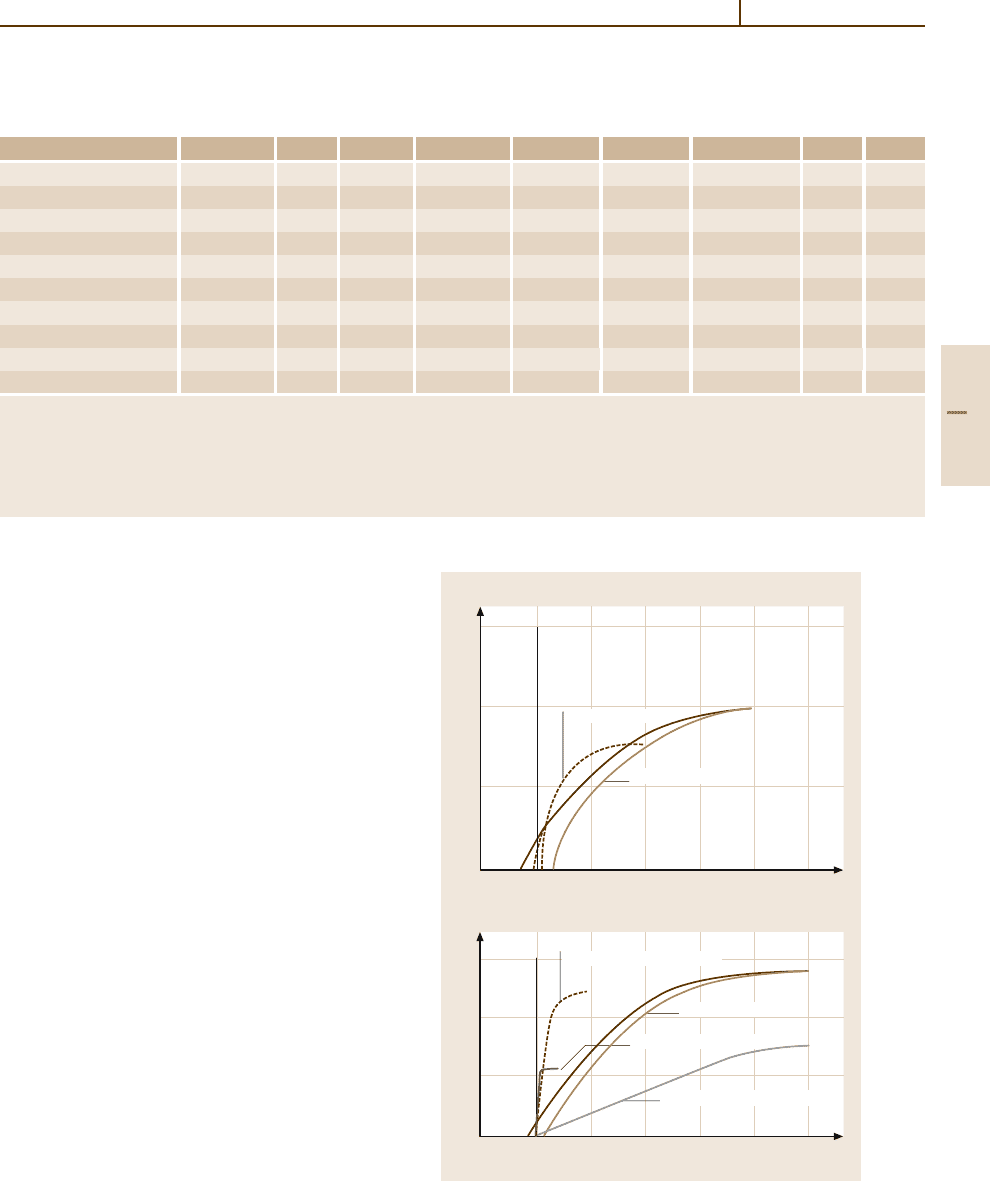
Magnetic Materials 3.2 Soft Magnetic Alloys 779
Table 4.3-24 Typical values of grain size D, saturation magnetization J
s
, saturation magnetostriction λ
s
, coercivity H
c
, initial
permeability µ
i
, electrical resistivity ρ, core losses P
Fe
at 0.2 T, 100 kHz and ribbon thickness t for nanocrystalline, amorphous,
and crystalline soft magnetic ribbons
Alloy D (nm) J
s
(T) λ
s
(10
−6
) H
c
(Am
−1
) µ
i
(1 kHz) ρ (µ cm) P
Fe
(Wkg
−1
) t (µm) Ref
Fe
73.5
Cu
1
NB
3
Si
13.5
B
9
13 1.24 2.1 0.5 100 000 118 38 18
a
Fe
73.5
Cu
1
NB
3
Si
15.5
B
7
14 1.23 ∼ 0 0.4 110 000 115 35 21
b
Fe
84
NB
7
B
9
9 1.49 0.1 8 22 000 58 76 22
c
Fe
86
Cu
1
Zr
7
B
6
10 1.52 ∼ 0 3.2 48 000 56 116 20
c
Fe
91
Zr
7
B
3
17 1.63 −1.1 5.6 22 000 44 80 18
c
Co
68
Fe
4
(MoSiB)
28
amorphous 0.55 ∼ 0 0.3 150 000 135 35 23
b
Co
72
(FeMn)
5
(MoSiB)
23
amorphous 0.8 ∼ 0 0.5 3000 130 40 23
b
Fe
76
(SiB)
24
amorphous 1.45 32 3 8000 135 50 23
b
80 % Ni
−
Fe (permalloys) ∼100 000 0.75 < 1 0.5 100 000
d
55 >90
e
50
b
50–60 % Ni
−
Fe ∼100 000 1.55 25 5 40 000
d
45 >200
e
70
b
a
[3.36]
b
Typical commercial grades for low remanence hysteresis loops, Vacuumschmelze GmbH 1990, 1993
c
[3.37,38]
d
50 Hz-values
e
Lower bound due to eddy currents
the domain wall thickness), which leads to the extreme
variation of K with the sixth power of grain size. These
relations were confirmed experimentally and result in an
anomalous variation of the coercivity with grain size, as
shown in Fig. 4.3-28.
Another type of nanocrystalline soft magnetic ma-
terials is based on Fe
−
Zr
−
B
−
Cu alloys [3.37, 38].
A typical composition is Fe
86
Zr
7
B
6
Cu
1
.AsZrpro-
vides high glass-forming ability, the total content of
glass-forming elements can be set to 20 at.%. As
a consequence the Fe content is higher, which implies
higher saturation polarization. The nanocrystalline mi-
crostructure consists of a crystalline α-Fe phase with
grain sizes of about 10 nm embedded in an amorphous
residual phase. After annealing at 600
◦
C, an opti-
mum combination of magnetic properties is obtained:
I
s
≥ 1.5T, H
c
≈ 3Am
−1
, λ
s
≈ 0. Because of the high
reactivity of Zr with oxygen the preparation of this type
of alloy is difficult. The production of these materials on
an industrial scale has not yet succeeded.
Table 4.3-24 shows the magnetic and physical prop-
erties of some commercially-available nanocrystalline
alloys for comparison to amorphous and Ni
−
Fe-based
crystalline soft magnetic alloys. Magnetic field an-
nealing allows the shape of the hysteresis loops of
Fig. 4.3-29a,b Soft magnetic alloys with flat hysteresis
loops:
(a) Crystalline. (b) Amorphous and nanocrys-
talline (curve indicated by n) [3.12]
1.5
1.0
0.5
0
–200 20406080100
–20 0 20 40 60 80 100
1.5
1.0
0.5
0
Flux density B(T)
a)
Field strength H(A/m)
75–80% NiFe
54–68% NiFe
b)
Flux density B(T)
Field strength H(A/m)
Fe
73.5
Cu
1
Nb
3
Si
13.5
B
9
(n)
Fe
76
Si
12
B
12
Co
67
Fe
4
Mo
1
Si
17
B
11
Co
71
Fe
1
Mn
4
Mo
1
Si
14
B
9
Part 4 3.2
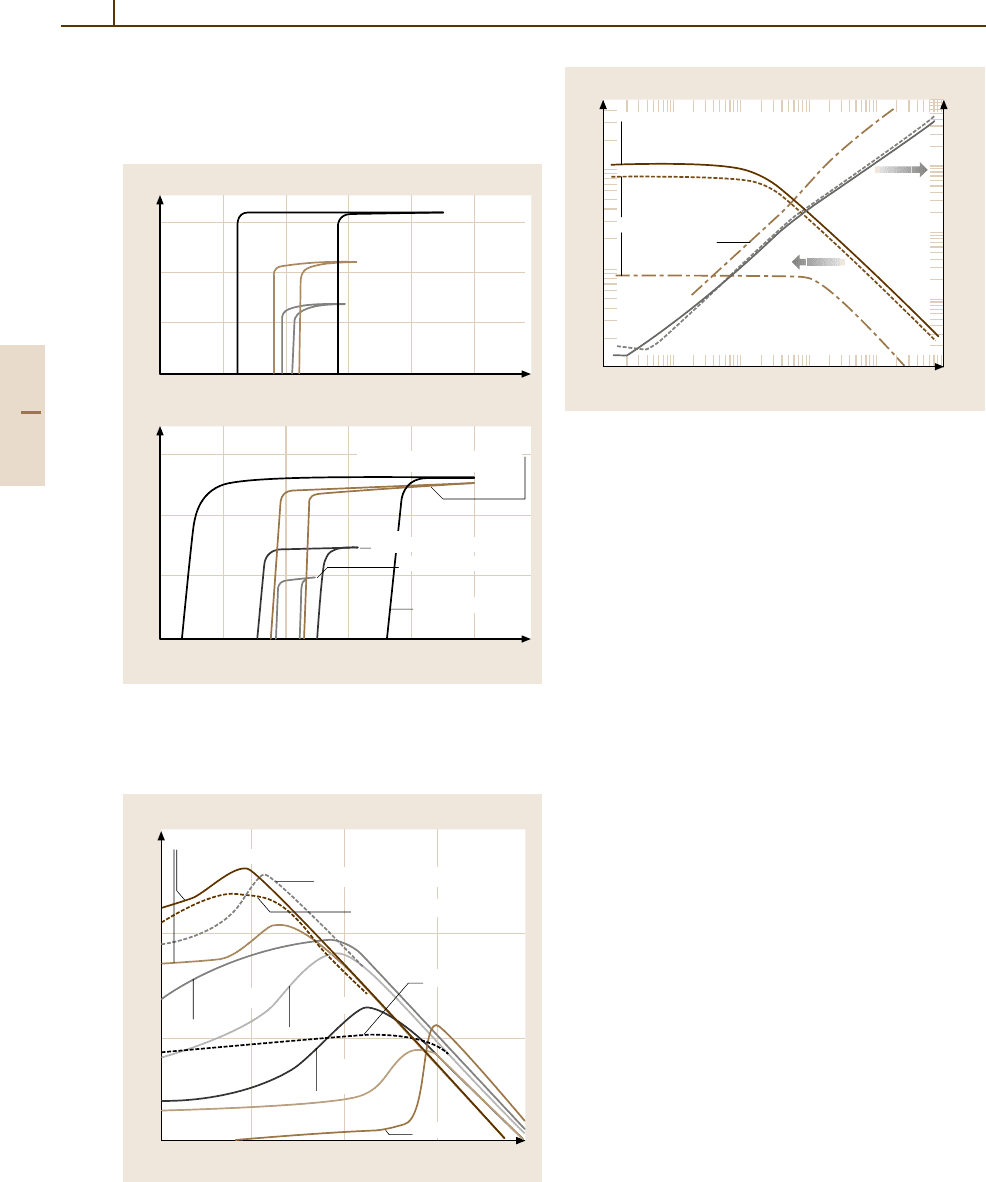
780 Part 4 Functional Materials
nanocrystalline soft magnetic alloys to be varied accord-
ing to the demands of the users. Accordingly, different
shapes of hystesis loops (Z, F, or R type) may be
1.5
1.0
0.5
0
–40 –20 0 20 40 60
1.5
1.0
0.5
0
–40 –20 0 20 40 60
Fe
73.5
Cu
1
Nb
3
Si
13.5
B
9
(n)
Fe
76
Si
12
B
12
Co
67
Fe
4
Mo
1
Si
17
B
11
Co
71
Fe
1
Mn
4
Mo
1
Si
14
B
9
Flux density B(T)
Field strength H(Am
–1
)
45–50% NiFe
54–68% NiFe
75–80% NiFe
Flux density B(T)
Field strength H(Am
–1
)
Fig. 4.3-30a,b Soft magnetic alloys with rectangular
hysteresis loops:
(a) Crystalline. (b) amorphous and
nanocrystalline (curve indicated by n) [3.12]
10
6
10
5
10
4
10
3
0.1 1 10
10
2
10
3
Field strength H
ˆ
(Am
–1
)
Amplitude permeability µ
a
Fe
73.5
Cu
1
Nb
3
Si
13.5
B
9
(n)
Fe
76
Si
12
B
12
(a)
Co
67
Fe
4
Mo
1
Si
17
B
11
(a)
75–80% NiFe
54–68%
NiFe
45–50%
NiFe
35–40%
NiFe
50% CoFe
10
5
10
4
10
3
10
–4
10
–5
10
–6
0.1 1 10 100 1000 10000
Fe
73.5
Cu
1
Nb
3
Si
15.5
B
7
Co
68
Fe
4
(MoSiB)
28
⏐µ⏐ µ''/⏐µ⏐
2
Frequency f (kHz)
nanocrystalline
amorphous
Mn-Zn ferrite
(Siferrit T38)
Fig. 4.3-32 Frequency dependence of permeability, |µ|,
and the relative loss factor, µ
/|µ|
2
, for nanocrystalline
Fe
73.5
Cu
1
Nb
3
Si
15.5
B
7
and comparable, low remanence
soft magnetic materials used for common mode choke
cores [3.23]
achieved. For comparison several characteristic hystere-
sis loops of crystalline, amorphous, and nanocrystalline
soft magnetic alloys are shown in Figs. 4.3-29a,b and
4.3-30a,b.
A survey of the field dependence of the ampli-
tude permeability of various crystalline, amorphous,
and nanocrystalline soft magnetic alloys is given in
Fig. 4.3-31 [3.12]. Figure 4.3-32 [3.23] represents the
frequency behavior of the permeability |µ| of different
soft magnetic materials for comparison.
4.3.2.8 Invar and Elinvar Alloys
The term invar alloys is used for some groups of alloys
characterized by having temperature-invariant proper-
ties, either temperature-independent volume (invar) or
temperature-independent elastic properties (elinvar) in
a limited temperature range. A comprehensive survey
of the physics and applications of invar alloys is given
in [3.17].
Invar Alloys
With the discovery of an Fe–36 wt% Ni alloy with an
uncommonly low thermal expansion coefficient (TEC)
around room temperature and called “Invar” by Guil-
Fig. 4.3-31 Amplitude permeability–field strength curves
of soft magnetic alloys ( f = 50 Hz): amorphous (a);
nanocrystalline (n) [3.12]
Part 4 3.2
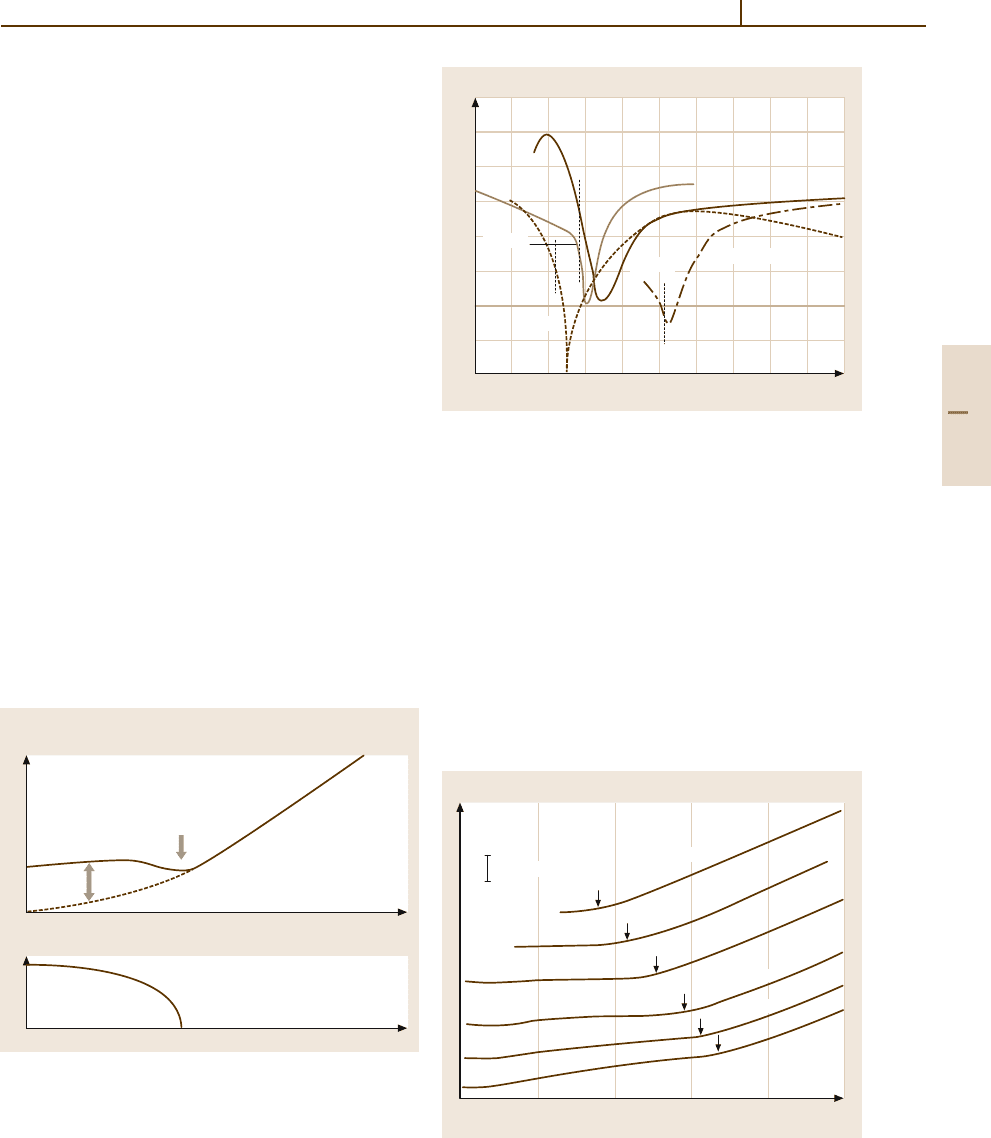
Magnetic Materials 3.2 Soft Magnetic Alloys 781
laume in the 1890s, the history of invar and elinvar type
alloys began. Below the magnetic transition tempera-
ture, Curie temperature T
c
or Néel temperature T
N
of
ferromagnetic or antiferromagnetic materials, a sponta-
neous volume magnetostriction ω
s
sets in. With some
alloy compositions, ω
s
is comparable in magnitude to
the linear thermal expansion but opposite in sign. As
a result the coefficient of linear thermal expansion may
become low and even zero.
The linear (α) and volumetric (β) thermal expansion
coefficients (TECs) are defined as:
α = (1/l)(∆l/∆T )
P
[K
−1
]
and
β =(1/V)(∆V/∆T )
P
[K
−1
] ,
with l = length, V = volume, and T = temperature. If
the alloys are isotropic the volumetric thermal expansion
coefficient is equal to three times the linear TEC:
β =3α.
The spontaneous volume magnetostriction ω
s
is in a first
approximation:
ω
s
= κCM
2
s
,
with κ = compressibility, C = magnetovolume cou-
pling constant, and M
s
= spontaneous magnetization.
Figure 4.3-33 [3.42] illustrates schematically the
a)
b)
Fractional volume change ( )
M
T
T
Ω
Fig. 4.3-33 (a) Schematic diagram of invar-type thermal-
expansion anomaly. The dashed curve indicates thermal
expansion for hypothetical paramagnetic state. The dif-
ference between the two curves corresponds to the
spontaneous volume magnetostriction, ω
s
. (b) Temperature
dependence of the spontaneous magnetization
24
20
16
12
8
4
0
–4
–8
0 20406080100
Ni, Pd, Pt or Co (at.%)
(10
–6
°C
–1
)
α
Fe–Pd
Fe–Pt
Fe–Ni
(Fe–Co)
89
Cr
11
Fig. 4.3-34 Temperature coefficient of linear thermal ex-
pansion α at room temperature as a function of the
composition in typical invar alloy systems: Fe
−
Ni [3.39],
Fe
−
Pt [3.40], Fe
−
Pd [3.40], and Fe
−
Co
−
Cr [3.39]. Ve r-
tical dotted lines show boundary between bcc and fcc
phases
temperature-dependent behavior of thermal expansion,
ω
s
and M
s
, which give rise to a small linear expansion
coefficient.
Crystalline invar alloys are essentially based on 4 bi-
nary alloy systems: Fe
−
Ni, Fe
−
Pt, Fe
−
Pd, and Fe
−
Co,
containing a few percent of Cr. Figure 4.3-34 [3.17]
shows the thermal expansion coefficient of these invar
type alloy systems. The invar alloy in each system is fcc
0 200 400 600 800
1000
T(K)
3×10
–2
∆
/l
Fe
100–x
Ni
x
x = 29.9
T
c
32.5
35.5
37.5
40.0
42.7
Fig. 4.3-35 Thermal expansion curves of Fe
−
Ni alloys
annealed at 1323 K for 5 days [3.41]
Part 4 3.2
